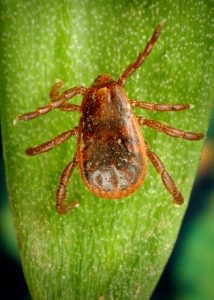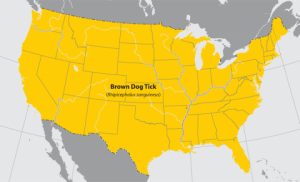Yes, ticks and mosquitoes both reside in Colorado. At this time, Colorado is home to 27 different species of ticks. Fortunately, several of the most significant tick species such as the lone star tick that is found elsewhere in the United States are either uncommon or absent from the state.
The problem with ticks is their ability to spread some serious diseases such as Lyme disease. In this blog post, we’ll look at the tick presence in Colorado and share some tips on how you can deal with it.
Are Ticks Common in Colorado?
In Colorado, ticks are rather widespread, especially in wooded and grassy areas, and especially areas with lots of brush. There are also a greater population of ticks in Eastern Colorado where it is more humid, as Western Colorado is more arid and ticks don’t get along with dry weather so much. Ticks prefer humidity. Keep in mind, though, that Colorado is becoming more humid (in fact, Boulder was ranked #3 in the USA on average dewpoint increases since 1970).
in Eastern Colorado where it is more humid, as Western Colorado is more arid and ticks don’t get along with dry weather so much. Ticks prefer humidity. Keep in mind, though, that Colorado is becoming more humid (in fact, Boulder was ranked #3 in the USA on average dewpoint increases since 1970).
The tick season typically starts in the spring around March and peaks around May, but it continues to be active through the end of fall.
These small organisms are most active between six in the morning and noon and can live up to 10,500 feet above sea level.
Are Ticks Increasing in Colorado?
Ticks are relatively common in Colorado, especially in regions with more brush and at higher elevations. The tick season normally begins in March and peaks in May, but tick activity lasts through the end of the summer.
They may dwell up to 10,500 feet above sea level and are most active between the hours of six in the morning and noon.
According to a recent study headed by Colorado State University researchers, ticks that can spread diseases including Rocky Mountain spotted fever, Colorado tick fever, Lyme, and tick-borne paralysis pose an increasing hazard in Colorado.
The study, which was supported by the Bay Area Lyme Foundation, revealed that Colorado’s 16 counties where American dog ticks had not previously been detected by the Centers for Disease Control and Prevention are home to the pests. Rocky Mountain wood ticks were discovered in 38 of Colorado’s 64 counties, compared to only 33 counties where they had previously been recognized.
What Are The Common Types Of Ticks In Colorado?
There are 28 identified kinds of ticks in Colorado that can be dangerous to humans and animals, although only five of these ticks are known to feed on humans.
American Dog Tick (Wood tick)
American Dog ticks are more common in the east of the country, but they can also be found in several counties in Colorado and on the west coast. The spring and summer are when they bite the most, going for medium-sized to large animals, including people and dogs.
summer are when they bite the most, going for medium-sized to large animals, including people and dogs.
Dog ticks are what many know as the good, old-fashioned “wood tick”.
Human bites are most frequently caused by female dog ticks. Infections like Rocky Mountain spotted fever and tularemia are among the diseases they can spread.
Rocky Mountain Wood tick
Rocky Mountain Wood ticks are found in the western half of Canada, Rocky Mountain states, and west coast states. They are common in Colorado from the beginning of spring to June and usually latch onto large mammals including people, dogs, cows, deer, and horses.
These ticks, which reside at altitudes of 4,000 to 10,500 feet, are the carriers of tularemia, Rocky Mountain spotted fever, and Colorado tick fever.
Brown Dog tick

The Brown Dog tick has been identified in each of the 50 states and is one of the most prolific pests to feed on our pets. This tick may live its entire life indoors and favors inhabited areas over undeveloped areas of the landscape.
Although brown dog ticks favor dogs as hosts, they have been observed to feed on humans and other species. Along with Rocky Mountain Spotted Fever, these ticks can also transmit several less well-known diseases to humans and canines.
Lone Star tick
The Amblyomma americanum, often known as the lone star tick, is a vicious biter of people, animals, and ground-dwelling birds. Even though they haven’t settled in Colorado, tales of them in a couple of its counties suggest that they are probably staying with hosts from other states.
Lone Star ticks carry the scary Alpha Gal Syndrome, so they need to be taken seriously.
These ticks can be identified by a single white “star” or dot on their back. It is known to spread tularemia, STARI, and the Heartland virus.
Soft-bodied ticks
The western states are home to soft-bodied ticks, which typically live between 1,500 and 8,000 feet in forests and rodent-infested areas. Extra caution should be exercised to prevent contact with these insects when camping near ancient barns, cottages, or other buildings.
Soft-bodied ticks, in contrast to many others, can survive for a long time between feedings and nearly double in size following a substantial meal of blood. It is well known that these ticks can transmit relapsing fever.
What Diseases Do Ticks Carry In Colorado?

Even though Lyme disease is frequently associated with ticks, Colorado thankfully lacks the species that transmits that specific ailment — for now. That tick, the Blacklegged or Deer tick, is found as far west as Western Kansas and Oklahoma, so they are knocking on Colorado’s door.
Nonetheless, a tick bite can transmit other diseases. Furthermore, it’s crucial to remember that not all tick bites result in an infection, but awareness is still crucial.
Tick-borne relapsing fever
This sickness, also known as “TBRF,” is frequently contracted while sleeping in old wooden structures, particularly cabins in the mountains.
The primary symptoms are headaches, aches in the muscles, and a temperature that can reach 103°F and lasts for three days before disappearing for a week and returning for another three days. The cycle can continue until antibiotics are used to stop it.
Tularemia
The symptoms of the bacterial infection of tularemia vary depending on where it enters the body and can affect both humans and animals. In cases ranging from moderate to life-threatening, this sickness can result in high fevers and ulceration. Antibiotics are frequently effective in treating patients.
Rocky Mountain Spotted Fever
If Rocky Mountain Spotted Fever is not promptly and appropriately treated with the right medicines, it can be fatal. People who have been bitten by a tick should seek medical attention right away since, if left untreated, this dreaded disease can spread extremely quickly.
Rash, fever, nausea, vomiting, anorexia, headaches, and stomach pain are some of the symptoms that can appear. Nearly all infected people develop rashes, which first show up a few days after the fever starts.
Colorado Tick Fever
Although there are no recognized therapies for Colorado tick fever, it is a rare viral disease that does not pose a life-threatening risk. Wood ticks from the Rocky Mountains spread it.
There is a two-week incubation phase, and the symptoms are chills, fever, exhaustion, sore throat, vomiting, pains, and rashes.
Many infected individuals will experience milder forms of the illness, including fatigue that can linger for a few weeks, but others may experience recurrent symptoms for some time.
How To Prevent Tick Bites?
You’re out in the wilderness, and bugs are part and parcel of it. However, there are a few things you can do to keep your tick contact to a minimum. 
Avoid Tick Habitats
Ticks tend to congregate in areas where their animal hosts travel most frequently in the spring and early summer. For example, paths that are frequently taken through grassy regions and shrublands or brushy areas that border fields and wooded areas.
When possible, avoid these areas during the tick season. When walking on paths, stay in the middle to avoid brushing vegetation that ticks use as perches.
Wear Protective Clothing
You can prevent ticks from latching onto your skin by wearing long pants, long sleeves, and thicker clothes to prevent skin contact. Pulling your socks of the bottoms of your leg pants is also an excellent way of closing the gaps and keeping ticks out if you are brushing against low vegetation.
You can also wear light-colored clothing so you can easily spot ticks on your clothes before they get onto your skin.
Use Tick Repellents
We did a piece on tick repellents that you should read if you want to learn more about this.
Ticks are effectively repelled by several repellents. DEET is most frequently found, although three additional options—picaridin, IR3535, and oil of lemon eucalyptus—are also suggested. These are applied to garments or the skin directly.
When applied to lower body parts like pants and other places where ticks are likely to land, repellents work best.
Using tick repellent in your yard can be useful, too, if you think you have a larger population. There are both commercial yard tick repellents as well as homemade yard tick repellent options.
How To Use Tick Repellents Safely
Tick repellents often have powerful and harsh chemicals that need to be treated with caution. 
- No high-concentration formulations should be used on youngsters
- To effectively repel ticks, which typically climb on clothing, apply the repellent to your clothes rather than your skin.
- Never put repellant on your hands or any other area that might touch your mouth.
- Avoid using repellents on open wounds or inflamed skin.
- Wash or bathe the affected areas after usage, especially with the elderly and young children.
- Permethrin is great to be applied on clothes as an alternative treatment. Permethrin-treated clothing can kill or deter ticks for even weeks, and it frequently retains its effectiveness after a few items of washing. Direct application of permethrin to the skin is not advised.
Checking For Ticks
After every hike or adventure in the bush, be certain to look for ticks by checking for ticks in all of the hotspots
There’s no need to freak out if you discover a tick adhering to your skin. The important thing is to get rid of it right away.
How Should I Remove a Tick?
A tick’s removal might be challenging once it has firmly attached to the skin, so use caution. The barbed mouthpieces may stay in place after removal and spread infection since they are barb-tipped.
Fortunately, because it has relatively short mouthparts, the Rocky Mountain wood tick, which is the most prevalent species in Colorado, is simple to get rid of. Ticks should be removed using the following method:
- Take hold of the tick as close to the skin as you can with fine-tipped tweezers. To prevent the potential transfer of any disease organisms, cover your fingers with a tissue or thin plastic before removing the tick if you are unable to use tweezers.
- Straight away from the skin, pull the tick carefully and steadily. While removing the tick, be careful not to crush it.
- Pull the tick steadily and slowly away from your skin. As you remove the tick, try to avoid crushing it.
- Apply a disinfectant to the tick’s feeding location once it has been removed. When finished, wash your hands. Never use your fingers to squash a tick. A live tick should be disposed of by flushing it down the toilet, putting it in alcohol, sealing it in a bag or container, or wrapping it tightly in tape.
- Ticks can also be removed using various alternative techniques, such as using petroleum jelly or heating a match to them.
These techniques take a long time to work and are not always successful at getting rid of the tick. Having the tick removed immediately is better than waiting for the tick to naturally detach.
Consult a physician if, after removing a tick, you experience a rash or fever within a few weeks. Tell the doctor where, when, and how recently you were bitten by a tick, as well as how the tick likely came into your possession.
Final Thoughts
Being in nature also means the never-ending battle with creepy crawlies. However, with a few simple precautions and some preparations, you can minimize the damage that these bugs can do to you.
Don’t forget the bug spray especially during the hotter months, and have fun in Colorado!






